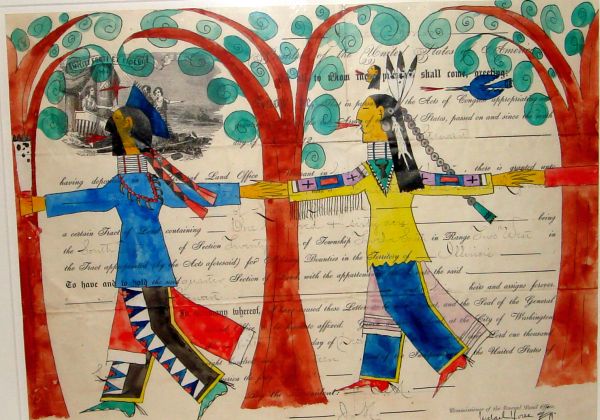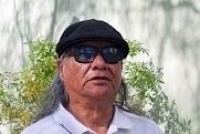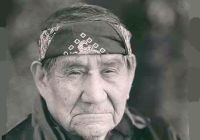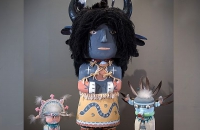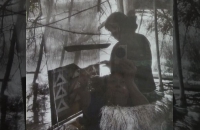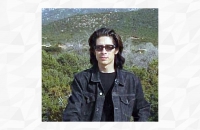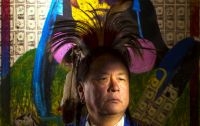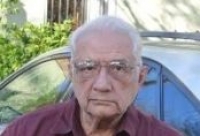Ledger painting by award winning artist Michael Horse. The 10” x 13 ½” watercolor is painted on an Illinois land grant, ca 1817.
Title: “The Men Celebrate Peace”
After days of meetings, the Councils of Grandmothers of the two disputing tribes finally reach an agreement that satisfies everyone. That afternoon the men celebrate with a dance, much to everyone’s delight.
Michael Horse was born near Tucson, Arizona of Yaqui, Zuni and Mescalero Apache decent. Michael is an actor, award winning artist and activist for Native American rights. He states that art is the way Native People celebrate their culture, religion and nature. His ledger paintings have been exhibited at the Smithsonian Institute in Washington D.C., Heard Museum in Phoenix, Arizona and galleries throughout the world.
About the artist
Michael Horse
(b. 1951 – present)
Michael Horse, of Yaqui, Mescalero Apache, Zuni, European and Hispanic descent, was born Michael Heinrich Horse in a place he calls “near Tucson”. He moved to Los Angeles, “the biggest urban Indian community in the U.S.,” when he was ten. There, Navajo, Cheyenne, and Sioux families surrounded him. He participated in the ceremonial dances at intertribal powwows from an early age.
Not surprisingly, given his network of resources and diverse tribal bonds, Horse turned out to be a “polymath”, mastering several traditional artistic disciplines. He learned jewelry-making from his uncles. His mother trained him in the flat style of painting promoted by Dorothy Dunn at the Santa Fe Indian School. She was also a potter and a kachina carver. As a young man, he studied at the Institute of American Indian Arts in Santa Fe with the painter Fritz Scholder, the stone sculptor Allen Houser, and the potter-turned-jewelry-maker Charles Loloma. Horse built a successful career as a sculptor and jewelry-maker himself, working the fairs, markets, and Native American arts festivals.
Michael learned how to make jewelry from family and other native artists who were kind enough to teach him. He had seen jewelry being made from the time he was a child. He says, “In my early silversmith career, I liked to make larger pieces, large silver bolos, horse bridals, and actual handmade silver sculptures. Someday, I hope to have time to go back and reexamine these pieces and do similar work again.”
“As long as I have been doing this,” Michael says, “I still never run out of inspiration or innovation in what can be done with this art form. Nature and spirituality are constant influences in my work. I am also inspired by non-Native artists such as Picasso and Michaelangelo, and I am inspired deeply by political artists, those who use their work to inspire others such as Diego Rivera.”
“I’m finding now that from my travel among other native cultures that I am starting to use images that I did not grow up with. I am inspired by other tribal artists. From the plains to South America to Africa, I’m finding that there are similar patterns among indigenous people around the world and that it is indeed a very small place. It is a place with similarities among us indigenous people that don’t seem to be
accidental. Michael had always been moved by the older kachina jewelry that had been made in the 1940s. These older pieces have inspired him to make amazingly detailed kachina bolos, earrings, and pendants.
During the Southwest Museum’s 20 year retrospective of his work, he realized that had not taken many photos of his work over his career. He had to try to round up pieces from collectors for the show. Upon seeing the body of his work, he realized the subtle changes it was going through as the years passed. He was also surprised to realize that some of his early work was as interesting as his new work.
“I go back and forth in my work, from the traditional to the contemporary, and I learn on this journey how the both are connected. One of the most rewarding aspects of being a jeweler is when I meet someone for the first time who owns a piece of my art, and they tell me how much they enjoy it and how many compliments they receive when they wear it. To me, that is a feeling like no other.”
Then, Horse made a discovery that shifted his orientation as an artist: ledger art.
“I have always been into arts. The acting was something that I had an opportunity to do. Art is my passion; it's my life. I grew up doing jewelry. I used to work for the Heye Foundation at the Museum of the American Indian in New York and when no one was looking I used to go sneak and look at stuff. That was where I first found this tribal art, the ledger art that I do. I was fascinated that first time I saw it and thought this is my history. Even though this was a plains style I knew that this was the way that all of us had recorded our history at one time. I used to just do this because I was a fan of the art form but now I am pretty much an authority on this art form. The last few years of doing this I thought to myself wherever you physically and culturally repressed people, this art exists. I am trying to put together an exhibition for the Smithsonian about the artwork that comes out of internment camps. The Museum of Tolerance in Los Angeles has a lot of drawings, similar to the ledger art, from the concentration camps. Similar works also exist from times of slavery in the South, on Angel Island, and now from Darfur.
In this country, the name itself hints at the history of this art form, which originated in the 1800s. Plains Indians, confined to reservations and deprived of the animal hides that served as supports for traditional painting, continued to make paintings using whatever materials they could find. Discarded sheets from the ledger books in which the white men kept track of their accounts were in abundant supply. These pages served as surfaces on which to preserve traditional stories and record contemporary events.
As a painter Michael Horse has brought reinvigorated inspiration to the traditional Native American style of “ledger art.” In the reservation era, as the practice of painting on buffalo hides became impossible, any “canvas” readily available took its place with various scrap papers such as book pages, old letters, maps and ledger books becoming background for visual recollections of heroic battles, scenes of ceremony, hunting and daily life. Newer implements such as crayons, colored pencils and water-colors allowed for a new breadth of detail. This traditional folk art was very free-flowing, Michael Horse points out, incorporating symbols and movement, almost like a film scene with images leading right off the pages in a very uncontained style. Having had the opportunity to see many of the old, original ledger drawings through his work with museums, Michael Horse explains its pull on him: “I knew this was my history book, coming from my point of view.”
Moved by the creativity and resourcefulness of his ancestors under such oppressive conditions, Horse undertook to reconceive ledger art as a contemporary genre. He continues to work in silver and stone, but his study of ledger art and output in the genre has made him a leading figure the field of contemporary painting and a source of inspiration for other artists and cultural producers. “I don’t copy,” he clarifies, “or imitate traditional material.” Rather he employs a traditional formal vocabulary to speak about the past in the present tense and shed light on cultural continuities.
He tracks down old documents to use as canvases: maps, marriage certificates, pages from ledgers and hymnals. He outlines his figures in black against this background and fills in the outlined forms with bright planes of color. A rider gallops astride a green horse amidst a herd of buffalo. Warriors charge into battle. Clans gather to celebrate a feast day. The figures are stylized and iconic. The dynamic compositions have an uneasy relationship to the page, as if resisting containment within its bounds. Man and beast are inscribed against a ground signifying extinction and interment — but they are light, swift, full of vitality. Many of the paintings bear biting titles: We Are Still Here, Don’t Take My Picture, This Land Is Your Land.
He is very proud of the paths that Native art have taken, as well as the path that it is moving toward with younger artists. He himself was inspired by some of his peers, and hopes that someday younger people might learn from and be inspired by some of his work.
A true modern day renaissance man, Michael is a jeweler, actor, stunt man, sculptor, painter and activist. As an actor, he has appeared in many movies and on television, including Twin Peaks, Passenger 57, Lakota Woman, and the CBC Canadian series, North of 60. His works of art have been shown in galleries throughout the world, and are currently available at the Southwest Museum in Los Angeles, the
Autry Museum of Western Heritage in Los Angeles, the Eiteljorg Museum in Indiana, Kiva Fine Art Gallery in Santa Fe, and Gathe Tribes Gallery in Albany, California.
He says that, “If somebody asked me how I would like to end my career, I would say I would like it to end with inspiring younger artists. I’m very interested in our youth. In the last few years, I’ve become involved with working with inner city and rural native youth, hoping that I might be able to steer them toward a more positive and creative path.”

